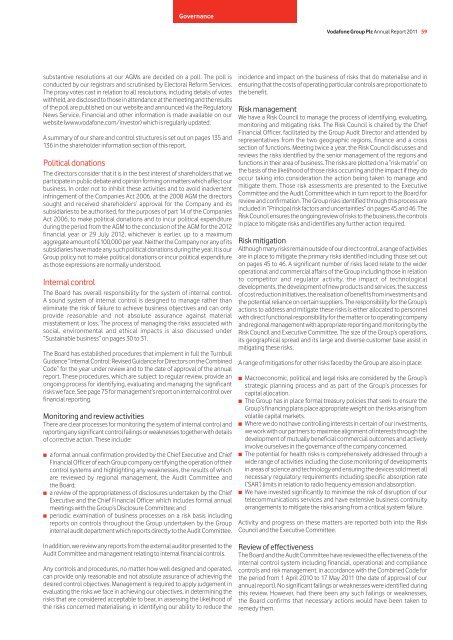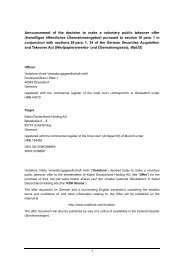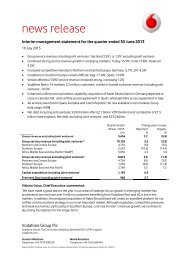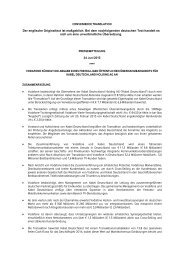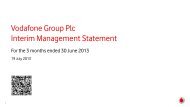Download the report - Vodafone
Download the report - Vodafone
Download the report - Vodafone
You also want an ePaper? Increase the reach of your titles
YUMPU automatically turns print PDFs into web optimized ePapers that Google loves.
Governance<br />
substantive resolutions at our AGMs are decided on a poll. The poll is<br />
conducted by our registrars and scrutinised by Electoral Reform Services.<br />
The proxy votes cast in relation to all resolutions, including details of votes<br />
withheld, are disclosed to those in attendance at <strong>the</strong> meeting and <strong>the</strong> results<br />
of <strong>the</strong> poll are published on our website and announced via <strong>the</strong> Regulatory<br />
News Service. Financial and o<strong>the</strong>r information is made available on our<br />
website (www.vodafone.com/investor) which is regularly updated.<br />
A summary of our share and control structures is set out on pages 135 and<br />
136 in <strong>the</strong> shareholder information section of this <strong>report</strong>.<br />
Political donations<br />
The directors consider that it is in <strong>the</strong> best interest of shareholders that we<br />
participate in public debate and opinion forming on matters which affect our<br />
business. In order not to inhibit <strong>the</strong>se activities and to avoid inadvertent<br />
infringement of <strong>the</strong> Companies Act 2006, at <strong>the</strong> 2008 AGM <strong>the</strong> directors<br />
sought and received shareholders’ approval for <strong>the</strong> Company and its<br />
subsidiaries to be authorised, for <strong>the</strong> purposes of part 14 of <strong>the</strong> Companies<br />
Act 2006, to make political donations and to incur political expenditure<br />
during <strong>the</strong> period from <strong>the</strong> AGM to <strong>the</strong> conclusion of <strong>the</strong> AGM for <strong>the</strong> 2012<br />
financial year or 29 July 2012, whichever is earlier, up to a maximum<br />
aggregate amount of £100,000 per year. Nei<strong>the</strong>r <strong>the</strong> Company nor any of its<br />
subsidiaries have made any such political donations during <strong>the</strong> year. It is our<br />
Group policy not to make political donations or incur political expenditure<br />
as those expressions are normally understood.<br />
Internal control<br />
The Board has overall responsibility for <strong>the</strong> system of internal control.<br />
A sound system of internal control is designed to manage ra<strong>the</strong>r than<br />
eliminate <strong>the</strong> risk of failure to achieve business objectives and can only<br />
provide reasonable and not absolute assurance against material<br />
misstatement or loss. The process of managing <strong>the</strong> risks associated with<br />
social, environmental and ethical impacts is also discussed under<br />
“Sustainable business” on pages 30 to 31.<br />
The Board has established procedures that implement in full <strong>the</strong> Turnbull<br />
Guidance “Internal Control: Revised Guidance for Directors on <strong>the</strong> Combined<br />
Code” for <strong>the</strong> year under review and to <strong>the</strong> date of approval of <strong>the</strong> annual<br />
<strong>report</strong>. These procedures, which are subject to regular review, provide an<br />
ongoing process for identifying, evaluating and managing <strong>the</strong> significant<br />
risks we face. See page 75 for management’s <strong>report</strong> on internal control over<br />
financial <strong>report</strong>ing.<br />
Monitoring and review activities<br />
There are clear processes for monitoring <strong>the</strong> system of internal control and<br />
<strong>report</strong>ing any significant control failings or weaknesses toge<strong>the</strong>r with details<br />
of corrective action. These include:<br />
■■ a formal annual confirmation provided by <strong>the</strong> Chief Executive and Chief<br />
Financial Officer of each Group company certifying <strong>the</strong> operation of <strong>the</strong>ir<br />
control systems and highlighting any weaknesses, <strong>the</strong> results of which<br />
are reviewed by regional management, <strong>the</strong> Audit Committee and<br />
<strong>the</strong> Board;<br />
■■ a review of <strong>the</strong> appropriateness of disclosures undertaken by <strong>the</strong> Chief<br />
Executive and <strong>the</strong> Chief Financial Officer which includes formal annual<br />
meetings with <strong>the</strong> Group’s Disclosure Committee; and<br />
■■ periodic examination of business processes on a risk basis including<br />
<strong>report</strong>s on controls throughout <strong>the</strong> Group undertaken by <strong>the</strong> Group<br />
internal audit department which <strong>report</strong>s directly to <strong>the</strong> Audit Committee.<br />
In addition, we review any <strong>report</strong>s from <strong>the</strong> external auditor presented to <strong>the</strong><br />
Audit Committee and management relating to internal financial controls.<br />
Any controls and procedures, no matter how well designed and operated,<br />
can provide only reasonable and not absolute assurance of achieving <strong>the</strong><br />
desired control objectives. Management is required to apply judgement in<br />
evaluating <strong>the</strong> risks we face in achieving our objectives, in determining <strong>the</strong><br />
risks that are considered acceptable to bear, in assessing <strong>the</strong> likelihood of<br />
<strong>the</strong> risks concerned materialising, in identifying our ability to reduce <strong>the</strong><br />
<strong>Vodafone</strong> Group Plc Annual Report 2011 59<br />
incidence and impact on <strong>the</strong> business of risks that do materialise and in<br />
ensuring that <strong>the</strong> costs of operating particular controls are proportionate to<br />
<strong>the</strong> benefit.<br />
Risk management<br />
We have a Risk Council to manage <strong>the</strong> process of identifying, evaluating,<br />
monitoring and mitigating risks. The Risk Council is chaired by <strong>the</strong> Chief<br />
Financial Officer, facilitated by <strong>the</strong> Group Audit Director and attended by<br />
representatives from <strong>the</strong> two geographic regions, finance and a cross<br />
section of functions. Meeting twice a year, <strong>the</strong> Risk Council discusses and<br />
reviews <strong>the</strong> risks identified by <strong>the</strong> senior management of <strong>the</strong> regions and<br />
functions in <strong>the</strong>ir area of business. The risks are plotted on a “risk matrix” on<br />
<strong>the</strong> basis of <strong>the</strong> likelihood of those risks occurring and <strong>the</strong> impact if <strong>the</strong>y do<br />
occur taking into consideration <strong>the</strong> action being taken to manage and<br />
mitigate <strong>the</strong>m. Those risk assessments are presented to <strong>the</strong> Executive<br />
Committee and <strong>the</strong> Audit Committee which in turn <strong>report</strong> to <strong>the</strong> Board for<br />
review and confirmation. The Group risks identified through this process are<br />
included in “Principal risk factors and uncertainties” on pages 45 and 46. The<br />
Risk Council ensures <strong>the</strong> ongoing review of risks to <strong>the</strong> business, <strong>the</strong> controls<br />
in place to mitigate risks and identifies any fur<strong>the</strong>r action required.<br />
Risk mitigation<br />
Although many risks remain outside of our direct control, a range of activities<br />
are in place to mitigate <strong>the</strong> primary risks identified including those set out<br />
on pages 45 to 46. A significant number of risks faced relate to <strong>the</strong> wider<br />
operational and commercial affairs of <strong>the</strong> Group including those in relation<br />
to competitor and regulator activity, <strong>the</strong> impact of technological<br />
developments, <strong>the</strong> development of new products and services, <strong>the</strong> success<br />
of cost reduction initiatives, <strong>the</strong> realisation of benefits from investments and<br />
<strong>the</strong> potential reliance on certain suppliers. The responsibility for <strong>the</strong> Group’s<br />
actions to address and mitigate <strong>the</strong>se risks is ei<strong>the</strong>r allocated to personnel<br />
with direct functional responsibility for <strong>the</strong> matter or to operating company<br />
and regional management with appropriate <strong>report</strong>ing and monitoring by <strong>the</strong><br />
Risk Council and Executive Committee. The size of <strong>the</strong> Group’s operations,<br />
its geographical spread and its large and diverse customer base assist in<br />
mitigating <strong>the</strong>se risks.<br />
A range of mitigations for o<strong>the</strong>r risks faced by <strong>the</strong> Group are also in place:<br />
■■ Macroeconomic, political and legal risks are considered by <strong>the</strong> Group’s<br />
strategic planning process and as part of <strong>the</strong> Group’s processes for<br />
capital allocation.<br />
■■ The Group has in place formal treasury policies that seek to ensure <strong>the</strong><br />
Group’s financing plans place appropriate weight on <strong>the</strong> risks arising from<br />
volatile capital markets.<br />
■■ Where we do not have controlling interests in certain of our investments,<br />
we work with our partners to maximise alignment of interests through <strong>the</strong><br />
development of mutually beneficial commercial outcomes and actively<br />
involve ourselves in <strong>the</strong> governance of <strong>the</strong> company concerned.<br />
■■ The potential for health risks is comprehensively addressed through a<br />
wide range of activities including <strong>the</strong> close monitoring of developments<br />
in areas of science and technology and ensuring <strong>the</strong> devices sold meet all<br />
necessary regulatory requirements including specific absorption rate<br />
(‘SAR’) limits in relation to radio frequency emission and absorption.<br />
■■ We have invested significantly to minimise <strong>the</strong> risk of disruption of our<br />
telecommunications services and have extensive business continuity<br />
arrangements to mitigate <strong>the</strong> risks arising from a critical system failure.<br />
Activity and progress on <strong>the</strong>se matters are <strong>report</strong>ed both into <strong>the</strong> Risk<br />
Council and <strong>the</strong> Executive Committee.<br />
Review of effectiveness<br />
The Board and <strong>the</strong> Audit Committee have reviewed <strong>the</strong> effectiveness of <strong>the</strong><br />
internal control system including financial, operational and compliance<br />
controls and risk management, in accordance with <strong>the</strong> Combined Code for<br />
<strong>the</strong> period from 1 April 2010 to 17 May 2011 (<strong>the</strong> date of approval of our<br />
annual <strong>report</strong>). No significant failings or weaknesses were identified during<br />
this review. However, had <strong>the</strong>re been any such failings or weaknesses,<br />
<strong>the</strong> Board confirms that necessary actions would have been taken to<br />
remedy <strong>the</strong>m.


